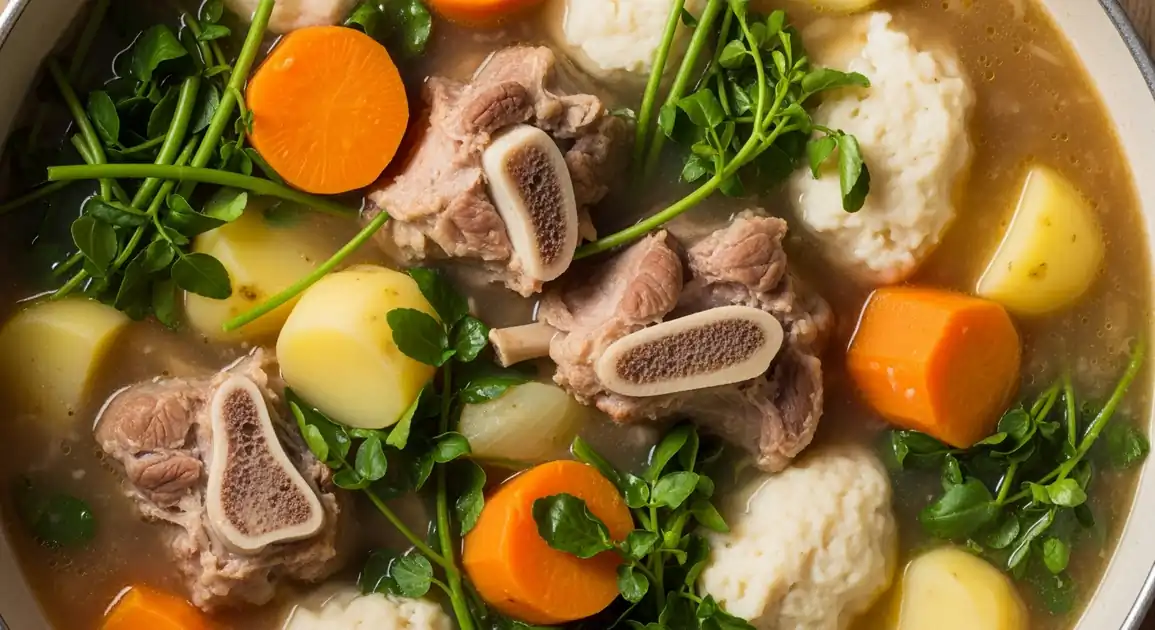Boil Up
Boil Up

Description
In Auckland, New Zealand's largest city, Boil Up can be found at specific Māori kai takeaways, particularly in South Auckland suburbs like Māngere or Ōtara, and at community events or markets. While not mainstream cafe fare, it's accessible for those seeking authentic Māori comfort food.
Dietary Information
Serving information
Serving style
Typically served hot in takeaway containers or bowls. A hearty, all-in-one meal.
Quick facts
Markets: Saturday mornings (approx 6 AM - 12 PM). Takeaways: Variable, often 11 AM - 7 PM or similar. Events: Specific times only.
Safety Tips
What to Look For
-
Served piping hot
Ensures the dish is at a safe temperature, minimizing bacterial risk, especially crucial at events or takeaways.
-
Meat tender and falling off the bone
Indicates it has been cooked long enough for both safety and quality.
-
Vegetables soft but not disintegrated
Shows proper cooking time – mushy vegetables might indicate it's old or overcooked.
-
Doughboys appear light and fully cooked
Should be fluffy, not dense or doughy in the center.
-
Clean serving environment
Observe the hygiene practices of the vendor or serving area, especially at temporary setups like markets or events.
What to avoid
-
Lukewarm temperature
Food held in the 'danger zone' (not hot enough or cold enough) allows bacteria to multiply. Insist on hot food.
-
Meat that looks dry or tough
Could indicate undercooking or poor quality reheating.
-
Greens that look slimy or overly yellowed
Suggests the greens were old or the dish has been sitting too long.
-
Dry, hard, or overly dense doughboys
Signifies they might be stale, improperly cooked, or reheated poorly.
-
Vendors with poor hygiene practices
Avoid places where food handling looks unsanitary (e.g., dirty utensils, poor hand hygiene).
Price information
Price range
Budget tips
- Check out markets like Ōtara Market on Saturday mornings for potential food stalls.
- Dedicated Māori kai takeaways often offer good value portions.
- Prices reflect the cost of ingredients (especially meat) and preparation time.
Value indicators
- Large serving size with plenty of meat, veg, and doughboys.
- Authentic taste, rich broth.
- Served fresh and hot.
- Good reviews or recommendations from locals.
Where to Find This Dish
South Auckland (e.g., Māngere, Ōtara, Manurewa)
Areas with significant Māori and Pasifika populations where specialty takeaways and community caterers are more common.
Ōtara Town Centre, Māngere Town Centre
Lunch, Dinner, Saturday mornings (Ōtara Market)
Ōtara Market
Large Polynesian market held on Saturday mornings, known for diverse food stalls including traditional Māori kai.
Ōtara Town Centre Carpark
Saturday Morning (approx 6 AM - 12 PM)
Specific Māori Kai Businesses
Search online for dedicated businesses like 'The Hangi Shop' or similar across Auckland (check menus as availability varies).
Search online maps for 'Maori kai Auckland'
Shop specific hours (usually Lunch/Dinner)
Community Events / Marae
Found at specific cultural festivals, fundraisers, or events hosted by local marae or community groups.
Event listings, Local marae websites/social media
Event specific times
Vendor Tips
- Go early to markets like Ōtara for the best selection, as popular food can sell out.
- Check Facebook or local community pages for announcements about food fundraisers selling Boil Up.
- Confirm opening hours for takeaways before visiting, as they can vary.
How to Order
Regional Variations
-
Takeaway Style Boil Up
(Takeaway Style Boil Up)
Portions served in standard takeaway containers, sometimes with slight recipe adjustments for commercial production.
-
Ingredient Availability
(Ingredient Availability)
While traditional ingredients are sought after, Auckland vendors consistently use kūmara, potato, pork bones, and common greens like watercress or cabbage.
Cultural context
History
Rooted in Māori traditions, Boil Up evolved as a way to utilize all parts of an animal and readily available vegetables. It became a staple comfort food, particularly significant during large gatherings ('hui') and family meals, embodying the principle of 'manaakitanga' (hospitality, kindness, and caring for others). While recipes vary between 'iwi' (tribes) and 'whānau' (families), the core concept of a nourishing, shared meal remains central.
Local significance
Represents a connection to Māori culture and tradition within the urban environment of Auckland. Provides a taste of home and comfort for the large Māori population living in the city.
Eating customs
- Consumed as a hearty, warming meal.
- Enjoyed casually in takeaway settings or at communal events.